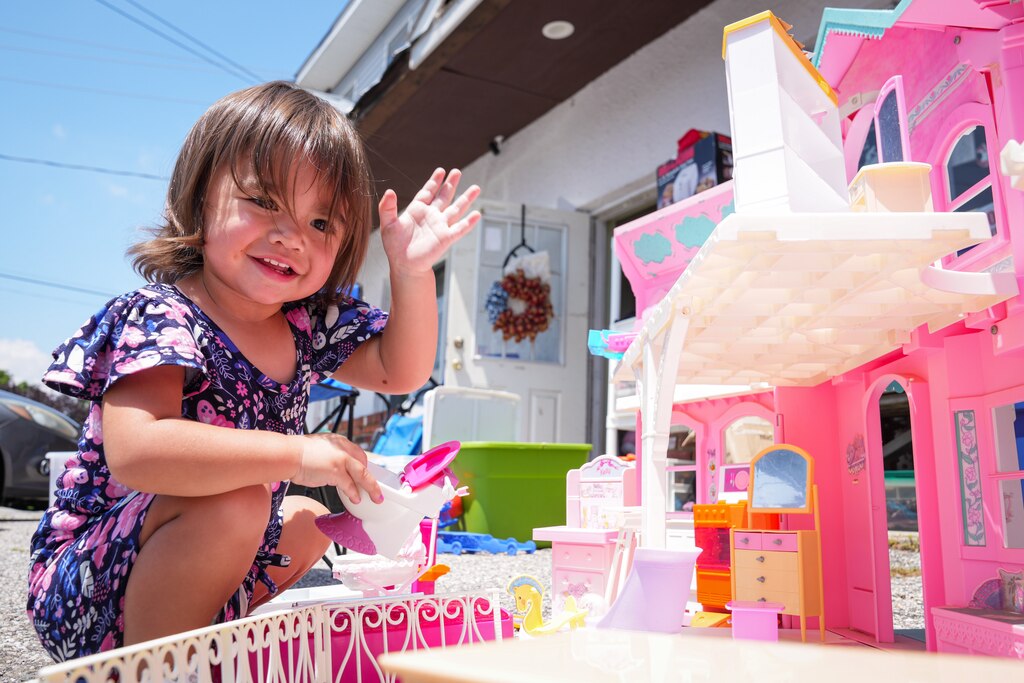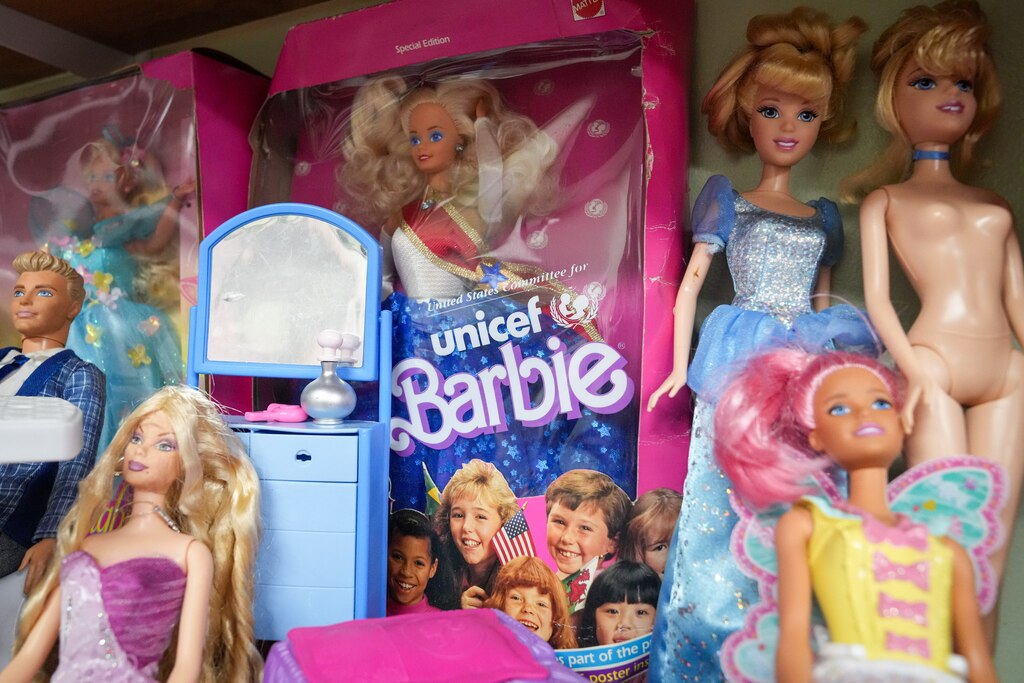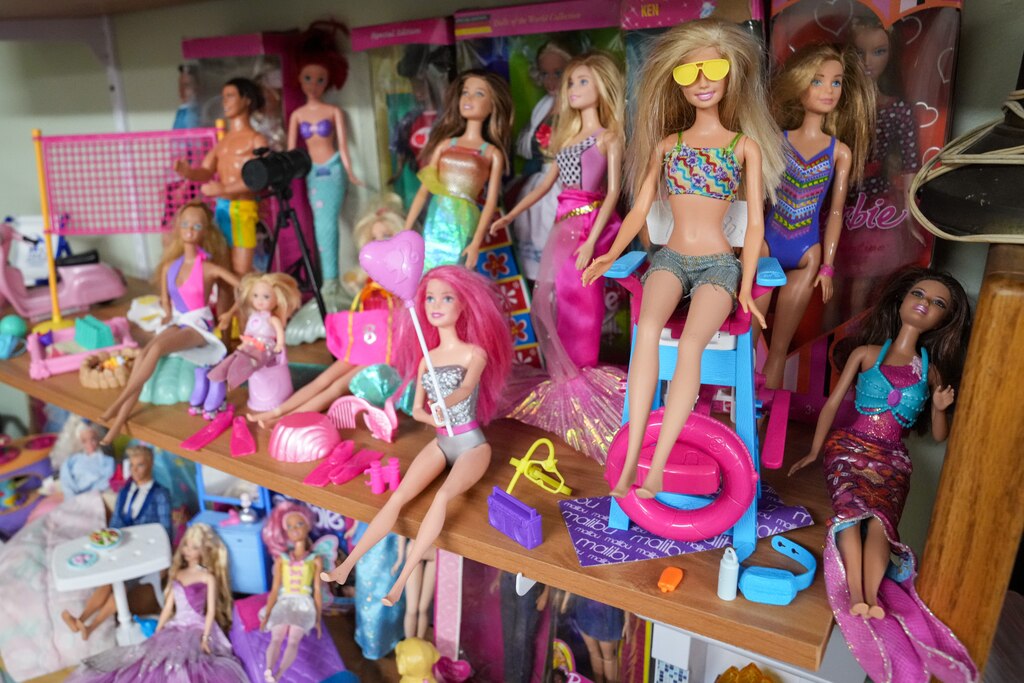May Brittingham was 8 years old when she was first smitten by the downcast, alluring eyes of the original 1959 Barbie. The doll, with curled bangs, a blonde ponytail, and a black and white striped swimsuit, was a present from her aunt, who didn’t have any daughters of her own.
Brittingham only owned the toy for a short while before her father auctioned it at his pawn shop, but the first glance was enough to spark an interest that would persist for decades. Now age 47, Brittingham has collected and sold the dolls ever since.
“I had Barbie everything when I was little,” she said. “I try to replace that stuff now that I’m older.”
Decades have passed, but Barbie has proved its staying power. The toy and its maker, Mattel, have been in business together for more than 60 years, and their relationship continues to be lucrative: Barbie brought in $1.49 billion for Mattel last year.
The Baltimore Banner thanks its sponsors. Become one.
“There’s a lot of people that collect Barbie,” said Brittingham, who runs Slim’s Pickings, a thrift shop of her own in Glen Burnie. “People in their 40s want to come back to their childhood. Especially in the past two months, people have been coming in wanting them.”

Part of that is due to the upcoming release of director Greta Gerwig’s “Barbie,” out Friday, which stars Margot Robbie as the titular toy and Ryan Gosling as her hot forever-companion, Ken. Film analysts predict the movie may earn $100 million in its opening weekend, according to The New York Times, but that’s just the latest of many accolades Barbie has collected since her inception. She’s claimed the spotlight in several museum exhibitions and was the subject of a 2018 documentary on Hulu. Two pop-up Malibu Barbie cafes are currently open for the summer in New York City and Chicago. Esteemed fashion designers such as Bob Mackie and Oscar de la Renta have taken their sewing skills to the miniature level to design her outfits in special collections over the years.
She was a game changer for toymakers and young kids alike. According to a history by Encyclopedia Britannica, baby dolls were the norm in the early ‘60s, which inadvertently encouraged young girls to envision themselves as nurturers, mothers or caregivers. Barbie was marketed as a woman of many careers with outfits to match.

In 1964, Barbie was a hospital volunteer. The next year, an astronaut. In 1973, she was a surgeon. In 1985, a CEO. She ran for president for the first time in 1992 and has entered every election year since. When kids played with her, they could imagine themselves in careers that don’t have enough female representation.
But her fame did not come without setbacks, especially when it came to accusations of setting unrealistic beauty standards. Researchers in Finland said in 1994 that if a real woman had the proportions of a Barbie doll, she wouldn’t have sufficient body fat for menstruation. One study in 2006 found that girls between the age of 5 and 8 who were exposed to the doll reported lower body esteem and an increased risk of developing disordered eating.
The Baltimore Banner thanks its sponsors. Become one.
From 2012 until 2015, Mattel faced several quarters of nose-diving sales and criticism continued as other companies manufactured dolls that better reflected the diversity of Americans in size, color and physical ability.
In the mid-2010s, Mattel released versions of Barbie in three body sizes — petite, tall and curvy — and sales turned up. The brand has also since released versions that represent Barbies with disabilities such as Down syndrome, prosthetic legs and wheelchairs. Mattel’s Barbie site touts its toys as “the most diverse doll line,” and notes that the dolls now come in “35 skin tones, 97 hairstyles, 9 body types and counting.”

The key to Barbie’s success, according to Bruce Zalkin, an antique toy and doll dealer from Sarasota, Florida, is her ability to keep up with the times.
Zalkin, 59, who has been collecting and selling Barbies for more than 35 years, has held over five toy shows near Towson University, where he appraises and buys the dolls from residents.
Zalkin purchased almost 80% of the dolls people brought there, mostly from women in their 60s who were curious about how much their old playthings could be worth. The answer? Quite a lot: He has sold individual dolls for more than $10,000. He sold one couple’s lifetime collection of mint-condition original dolls and clothes for $250,000.
The Baltimore Banner thanks its sponsors. Become one.
Before you run to your attic and prepare to claim riches, it’s important to know what makes a Barbie worth her dollars. Zalkin said it usually depends on how much she was loved — and whether her clothes adorn the signature hot pink Barbie tag that marks its legitimacy.
“Even to this day, all the clothing is tagged,” he said. The official clothes have always been expensive, he said, sometimes more pricey than the doll. “Mattel sold pattern books so that mothers and grandmothers could make their own clothes for the Barbies, because it was cheaper to do that than buy the Mattel clothes.”

To the trained eye, each iteration of Barbie has differences. For the first six months after her original release, she came with copper wiring in her feet to attach her to a stand, which was discontinued after kids repeatedly broke it. Subtly, she acquired mascara, acrylic paint or different hair textures. The rarity of Barbie’s clothes from specific lines can also differentiate a doll worth $20 and $1,500.
Zalkin, a toy seller since 13 years old, was introduced to Barbies in the early ‘90s after he opened a store in Tampa that his employees, who were mainly older women, helped him run. “They taught me everything I wanted to know and more” about the intricacies and allure of the doll, he said.
In his experience following the market rate of old Barbies, the original 1959 doll in perfect condition is worth between $5,000 to $10,000. But even that sum is not enough for some people to part with their favorite dolls.
The Baltimore Banner thanks its sponsors. Become one.
“You’ll have some people collecting for investment or they want mint-perfect times, and they’re going to pay the top premium for it,” Zalkin said. “Other collectors just want the doll, get it at one-tenth of the price, and they’ll redo the makeup, redo the hair and have the doll they want.”
Brittingham received three original Barbies — the 1959 version, as well as Barbie’s younger sister, Skipper, and her first friend, Midge — as a gift from her husband two years ago for $350. She also owns five of the six dolls in the Barbie and the Rockers collection and has the clothes for the sixth doll, a prize that could be worth hundreds. But they’re not going anywhere.
“My childhood friend that I went to nursery school with got me a Rocker Barbie two years ago for Christmas,” she said. “I would never sell her.”





Comments
Welcome to The Banner's subscriber-only commenting community. Please review our community guidelines.